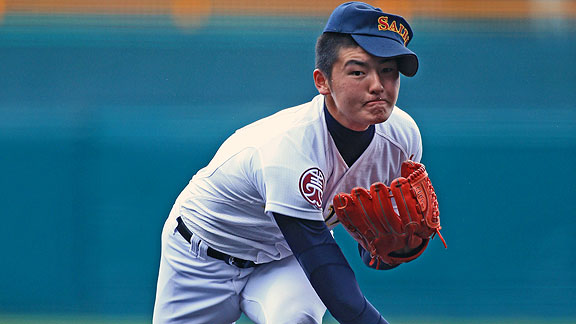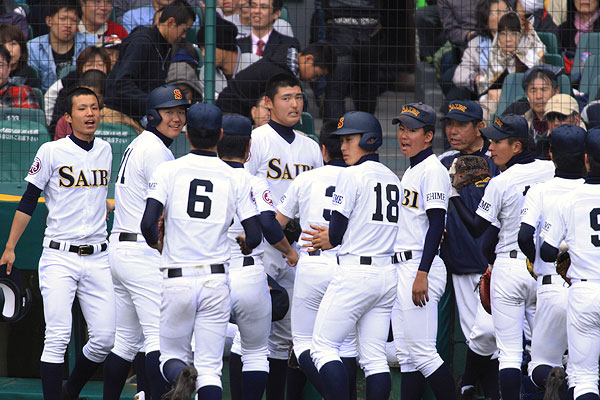16-year old phenom Tomohiro Anraku throws 772 pitches in Japan’s biggest tournament Koshien
Watch the ESPN feature on Anraku here: Video
Japan’s unique baseball culture reveres dominant young pitchers who often throw hundreds of pitches over a few days.
These are Tomohiro Anraku’s last moments of invisibility. Outside Japan, at least, he has been that ultra-rarity — the unseen sensation, a real-life Sidd Finch, his story so impossible that he’s been spoken about only in whispers or exclamations.
He is out there somewhere on this all-dirt field; he is one of these few dozen possible boys. But on this overcast Saturday morning in June, before the start of the first of two exhibition games in Akashi City, the greatest teenage pitcher in Japan — the best since Yu Darvish — and one of the top 16-year-old prospects in the world — as can’t miss as Stephen Strasburg — continues hiding in plain sight. Saibi High School isn’t wearing numbers on its white uniforms today. These boys never wear names. And from a distance, as they practice their drills with alarming precision, looking less like ballplayers and more like a marching band, like toy soldiers, any single one of them disappears into the lockstep crowd. An arm like Anraku’s, this inhuman appendage, must look different. It must have scales, or talons, or somehow drag across the earth, leaving fissures in its wake. But for now his arm is just another arm, and Anraku is just another player, his otherworldliness lost in this army of Japanese ordinary.
Masanori Joko, Saibi’s 66-year-old manager, stands like a general on a hill overlooking the field. “Is Anraku the one with the shaved head?” someone asks him, and he smiles. “They all have shaved heads,” he says through an interpreter, before he offers his only description: “He is the tallest one.”
There he is. That must be him. He is the tallest one by several inches, more than six feet tall, with a cap perched high on his head and a red glove on his left hand. His back is so broad, his shirt — the only one its size on this entire team — rides up his long arms. He has thick legs and a surprisingly American ass, and when his feet dig into the dirt, he ripples like a sprinter. He runs with another, much smaller boy into rightfield, the pair lost in the same cloud of dust, where they wait for a coach to hit a ball their way. When a pop fly settles into Anraku’s glove, his arm is put on display for the first time: He throws a one-hopper to the plate. A murmur rolls through the crowd. This is a good sign.
There has been talk in America that Anraku’s arm had been destroyed weeks earlier, in April, stripped of its powers at Koshien — a high school tournament that happens twice a year in Japan, in spring and in summer. Robert Whiting, author of You Gotta Have Wa and one of the West’s principal translators of Japanese culture, has a hard time capturing the meaning of Koshien, first held in 1915. “It’s like the Super Bowl and the World Series rolled into one,” he says. “It’s the closest thing Japan has to a national festival.” In the spring, 32 teams from across the country arrive at Koshien, the name of a beautiful stadium near Kobe but also the de facto title of the tournament that’s played there. (In the summer, 49 teams participate, one from each of Japan’s 47 diverse prefectures, plus an additional team from Tokyo and Hokkaido.) They meet in a frantic series of single-elimination games until a champion emerges. At any one time, 60% of Japan’s TV sets will be tuned in to the drama. More than 45,000 fans will be packed into the stadium, and if the games are especially good, many of those fans will be weeping.
“It’s not just baseball,” says Masato Yoshii, who pitched in two Koshiens long before he joined theNew York Mets. “It’s something else. It’s something more.”
This spring, Anraku single-handedly carried Saibi, from his hometown of Matsuyama, representing Ehime prefecture, to the final. He stood on the mound and felt he was exactly where he should be. His parents met at Koshien as young concession workers. His father was a promising pitcher who blew out his arm even before high school; he started his son pitching when he was 3 years old. In some ways, it seems as though Anraku never had much choice about any of this, and he would agree. The Japanese don’t use the word “destiny” very much. They call it fate.
He threw virtually every pitch for Saibi at Koshien, including a 13-inning complete game in which he threw 232 pitches. But in the awful final, he fell apart, terrifyingly and completely, eventually losing 17-1, pulled only after he’d thrown his 772nd pitch over five games in nine days. His fastball was not nearly so fast; his curveball no longer broke; his slider stayed flat. Every one of his instruments abandoned him, and yet he had continued to throw until his precious right arm hung limp at his side. Don Nomura, the agent who represents Darvish, told Yahoo’s Jeff Passan that Anraku’s treatment was nothing less than child abuse, a sentiment shared by several American scouts. Those strong words traveled over the ocean and upset many in Japan, where if anyone saw Tomohiro Anraku as a victim, he was blessed to be one. In fact, he’s been given the most coveted and celebrated title of all. He is a kaibutsu.
Anraku is a monster. Anraku is a beast.
Yet even in Japan there has been a rising unease regarding Anraku’s fate. Kazuhisa Nakamura, a 65-year-old journalist and former scout for the legendary Yomiuri Giants, sat in a Tokyo restaurant recently, stirring his coffee, shaking his head. “I felt sorry for him,” he said, remembering that final game. “It was so obvious. Everybody could see something was wrong.” The problem wasn’t that Anraku had thrown so many pitches. By Koshien’s measures, his performance was something like normal. Daisuke Matsuzaka had thrown 767 pitches in six games in 1998; even Darvish, who allegedly had been protected from the excesses of Japanese baseball culture by his Iranian father, threw 505 pitches in five games in 2003. What separated Anraku was how plainly he had faltered. It was like watching a prize colt find a hole in the track, only no tarps were put up to protect us from his agony. The torturous spectacle of this broken boy and the unkind Western attention that followed were enough for some Japanese to wonder whether Anraku represented everything that’s wrong with Koshien rather than everything that’s right. “Before, he was the No. 1 prospect in Japan, easily,” Nakamura said. “Now,” he said, and he stopped and shrugged.
“Now we have to wait and see.”
Two months after that fateful…
more via OTL: Japan’s Pitching Monsters – ESPN Video – ESPN.



